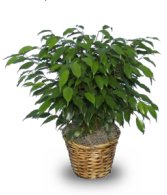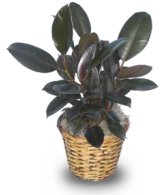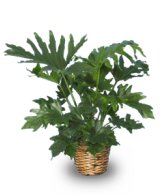Father’s Day is coming up this month (June 19), and if you’re stumped for a gift, why not send Dad a tropical houseplant to let him know how much you appreciate him? Your local florist has a selection of favorite houseplants from which to choose, including ficus plants and philodendrons – two sturdy specimens with a proven track record of flourishing indoors. Each one of these popular groups of houseplants occurs in several different, easy-care varieties, so you’ll be able to select the one that best suits your father’s personality and matches the growing conditions he’ll be able to provide.
 |
| Image of Benjamin Fig Ficus benjamina |
The word ‘ficus’ means ‘fig’ in Latin, and in addition to the tree that bears the tasty fruit of Fig Newton® fame, the ficus group contains some of our most universally popular houseplants, including the well-known Ficus benjamina, or Benjamin Fig. Ficus benjamina is the familiar ficus tree of shopping malls and hotel lobbies, noted for its handsome, silvery-gray bark and glossy green leaves. In warm climates, ficus trees are regularly planted as part of the outdoor landscape, where their versatility allows them either to be grown as shade trees or pruned into hedges. In colder regions, Ficus benjamina is often chosen for interiorscapes because it has the size and appearance of a familiar outdoor tree, bringing a welcome sense of the outside in. Given enough room and adequate light, they can grow to be two stories or more tall. Because of their tropical origins, ficus trees cannot tolerate temperatures below freezing, and they’ll often drop their leaves if the thermometer dips below 50° F.
Another member of the ficus family is the enduring rubber tree (Ficus elastica), a plant that has been grown indoors for generations. With its bold, leathery, dark green leaves and coarsely textured stem, the rubber tree presents a distinctly masculine appearance. The cultivar ‘Decora’ has even darker leaves with a reddish cast to them. Similar in habit to the rubber tree, but less commonly seen, is the fiddle-leaf fig (Ficus lyrata), which has glossy, broadly pear-shaped leaves up to 18″ long with deeply impressed veins, giving it a very sculptural appearance. Like the rubber tree, the fiddle-leaf fig reaches a height of 40 feet or more in its natural environment of tropical Africa. But don’t worry; it’s easy to keep within bounds in your living room just by pruning it back.
 |
| Image of Rubber Plant Ficus elastica |
All of the arborescent (tree-like) members of the ficus family respond well to the same care. Allow them to become slightly dry between thorough waterings. Never permit the soil to get so dry that the leaves wilt, which indicates that the fine root hairs that absorb moisture and nutrients are dying. Conversely, never let the soil become soggy and waterlogged, a condition that will drown the root hairs and quickly cause leaves to drop. Provide bright light; preferably near a sunny window, but most ficus trees will adapt to lower light situations. Ficus plants are heavy feeders, so fertilize monthly, spring and summer, with a balanced houseplant food. The large-leaved members of the ficus clan will accumulate dust, thereby blocking light from reaching the leaf surfaces, so be sure to wipe them regularly with a damp cloth or sponge. Ficus trees are somewhat notorious for dropping their leaves when they’re moved. Don’t worry too much if this happens; the plant is acclimating to its new environment and will grow new leaves once it’s adjusted.
You may be surprised to know that there is a small, vining, ivy-like member of the ficus family: the creeping fig (Ficus pumila). The creeping fig is a popular outdoor groundcover in tropical regions, where it will enthusiastically climb walls and tree trunks by means of its strongly adhesive aerial roots. This ficus has diminutive (1″ or less) leaves on slender, thread-like stems. It thrives in a moist, warm, and humid environment.
Philodendrons are a diverse group of plants, encompassing many forms from small, trailing vines to giant trees. The word ‘philodendron’ itself means ‘tree-loving’, referring to the vines’ tendency to grow up the trunks of trees in their native tropical jungles. Because philodendrons are well adapted to the shady conditions of the rain forest floor, they are excellent candidates for surviving in the low-light interiors of many homes and offices.
 |
| Image of Tree Philodendron Philodendron selloum |
One of the more sculptural philodendron varieties in cultivation is the tree philodendron (Philodendron selloum), which produces broad, shield-shaped leaves that are deeply incised along the wavy margins, creating long finger-like lobes. The cuts become deeper and wavier, and thus more dramatic, as the plant matures and the leaves become larger. Though it grows somewhat slowly, this philodendron has the potential to reach large proportions, gradually forming a thick and interestingly patterned ‘trunk’ as it naturally drops older leaves in favor of new ones. It also produces long, ropey aerial roots, which may be tucked back into the pot in order to help nourish the plant.
Hybridizers have, for years, been developing new philodendron cultivars with unusually colored foliage. These are bold-leaved plants with a masculine personality. For example, ‘Black Cardinal’ is a low-growing, shrubby philodendron with spade-shaped leaves that are so dark, they appear to be almost black. ‘Prince of Orange’ sports bright, bronze-toned leaves on vivid orange stems. Philodendron ‘Moonlight’ produces new leaves with a bright chartreuse color that ages to a subtle gray-green. The new foliage on ‘Imperial Red’ unrolls in a deep burgundy-red color, becoming dark green with a burgundy tint as it matures. All of these philodendrons are known as “self-heading” varieties, meaning that they grow slowly and stay low and compact, neither vining (and needing a bark support) nor developing a trunk like Philodendron selloum.
While most philodendrons are happy enough in low-light situations, the more colorful ones require brighter locations. All philodendrons should be kept evenly moist at all times, and fertilized regularly. The climbing types should be grown on a support, like a tree bark totem pole. Otherwise, the newly-produced leaves will become smaller and smaller. See our earlier newsletter for more philodendron care instructions.
You can see more pictures of these and other types of houseplants by visiting Flower Shop Network’s Gallery of Tropical Plants. Watch for future newsletters describing other kinds of tropical plants. And remember that your local professional florist can easily have one of these popular houseplants delivered to your Dad whether he lives nearby or out of town. How appropriate to send something green and growing to the man who did so much to help you grow when you were still green yourself.


